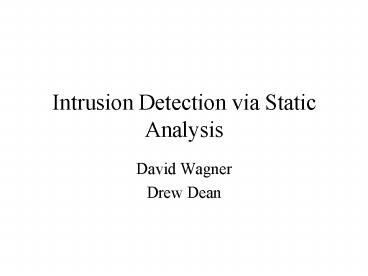Intrusion Detection via Static Analysis - PowerPoint PPT Presentation
1 / 12
Title:
Intrusion Detection via Static Analysis
Description:
Represent the system call trace as a non-deterministic finite automaton (NDFA) ... paths (by characterizing more precisely the set of possible syscall traces) ... – PowerPoint PPT presentation
Number of Views:26
Avg rating:3.0/5.0
Title: Intrusion Detection via Static Analysis
1
Intrusion Detection via Static Analysis
- David Wagner
- Drew Dean
2
Motivation
- New security problems are discovered every day
- Majority of security problems are buffer
overflows (foreign code is executed) and not
logic errors (native application code continues
to execute) - Try to solve this by monitoring applications for
any abnormal behavior
3
Framework
- Assumption A compromised application cannot
cause much harm unless it interacts with the
underlying operating system, and those
interactions may be readily monitored. - In most of the cases, the only way to interact
with an OS is via system calls. - Solution Monitor applications system call trace
for any unexpected interaction with an OS.
4
Trivial Model
- Create the set of system calls that the
application can ever make - If a system call outside of the allowed set is
executed, terminate the application - Pluses simple, easy to implement, efficient
- Minuses Fails to detect many attacks (i.e. ones
that use only system calls from the allowed set),
too coarse-grained (certain system calls can
cause a lot of damage, i.e. open() )
5
Callgraph Model
- Improves the trivial model by reintroducing the
ordering of the system calls - Represent the system call trace as a
non-deterministic finite automaton (NDFA) - Monitor the application by simulating the
operation of the NDFA on the observed system call
trace - Pluses more precise than the trivial model, does
not introduce any false positive alarms - Minuses harder to implement, not efficient,
includes impossible paths due to function call
treatment and presents certain risks due to
non-determinism of the model
6
Abstract Stack Model
- Improves the callgraph model by eliminating
impossible paths (by characterizing more
precisely the set of possible syscall traces) - Represent the system call trace as a
non-deterministic pushdown automaton (NDPDA) - Monitor the application by simulating the
operation of the NDPDA and comparing the
application call stack with a list of all valid
stacks - Pluses eliminates impossible paths
- Minuses much harder to monitor the application
efficiently
7
Digraph Model
- Combines some of the advantages of the callgraph
model in a simpler formulation - Model consists of a list of possible k-sequences
of consecutive system calls (k2 for simplicity) - Monitor the application by checking the executed
system calls vs. a precomputed list of the
allowed k-sequences - Pluses much more efficient than the callgraph or
abstract stack models - Minuses less precise than the callgraph or
abstract stack models
8
Implementation Issues
- Non-standard control
- Function pointers
- Signals
- Setjmp()
- Other modeling challenges
- Libraries
- Dynamic linking
- Threads
9
Optimizations
- Irrelevant systems calls
- Not monitoring harmless but frequently executed
system calls such as brk() can greatly improve
the performance - System call arguments
- Monitoring the arguments at runtime improves both
precision and performance
10
Evaluation
- Performance
- Precise callgraph and abstract stack models
introduce too much overhead - Mimicry attacks
- Require high precision models to detect (poor
performance)
11
Unaddressed issues
- Applying static analysis to binaries when source
code is not available - Explaining how runtime monitoring agent works and
how it can be used to improve the security and
the model precision (run as a separate SMT thread
with 0 overhead?)
12
Questions
- What are the ramifications of the callgraph model
non-determinism? - What are the risks of having k2 in the
k-sequences model?































